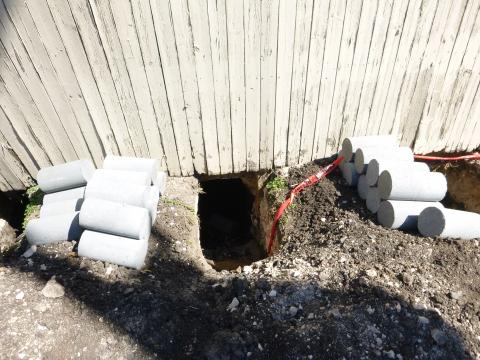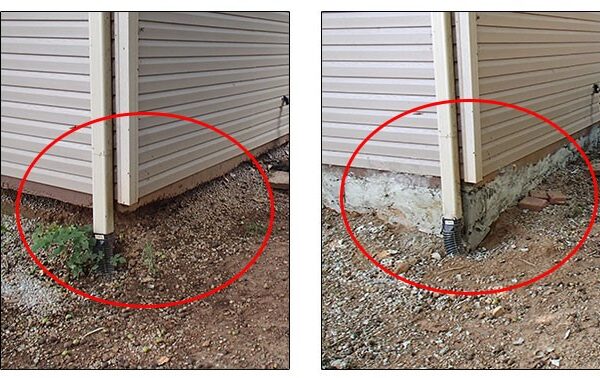Important Guide to Foundation Repair OKC: What Homeowners Required to Know
Important Guide to Foundation Repair OKC: What Homeowners Required to Know
Blog Article
Checking Out Different Approaches of Structure Repair Work for Different Soil Kinds
Foundation repair is an important element of maintaining architectural stability, especially when considering the diverse difficulties presented by various dirt types. The intricacy of soil habits under differing conditions demands a customized approach to repair, guaranteeing ideal options such as helical piers for unsteady dirts or chemical cements for natural layers.
Understanding Dirt Types
Soil kinds play a vital duty in the stability and long life of structure structures, making it essential for home owners and construction specialists to understand their characteristics and actions. The communication in between soil and structure can figure out the architectural integrity of a building. There are a number of soil kinds, each with distinct physical residential properties that impact exactly how structures are made and preserved.
Granular soils, such as sand and gravel, provide good drainage and are often considered steady. They have high load-bearing capacities, which can sustain heavier structures. Nevertheless, these dirts can move otherwise compressed correctly, resulting in possible settlement concerns. In contrast, natural dirts like clays and silts display various actions. These dirts have a tendency to keep dampness, and their load-bearing ability can differ substantially with adjustments in dampness material.
Rocky soils, known for their strength and security, deal superb assistance for foundations yet might call for specific equipment for excavation. Conversely, loamy soils, which are a balanced combination of clay, silt, and sand, typically provide positive conditions for structure assistance due to their modest drain residential or commercial properties.

Recognizing these soil types is important for choosing appropriate structure fixing approaches, ensuring the durability and security of frameworks in time.
Obstacles With Large Clay
Amongst the different dirt kinds, extensive clay provides distinct difficulties for foundation stability as a result of its propensity to undertake significant volume changes with wetness variation. This kind of dirt swells when wet and agreements when completely dry, which can put in significant pressure on structures. These variations can cause foundation cracking, heaving, and negotiation issues, presenting considerable threats to the structural honesty of structures.
The challenges with expansive clay are exacerbated by its plasticity index, which determines the soil's capability to transform form and volume. A high plasticity index suggests greater capacity for activity, boosting the probability of damages to structures. This is specifically problematic in areas experiencing extreme or frequent climate modifications, where cycles of damp and dry problems are typical.
Furthermore, the deepness of expansive clay layers can differ, complicating the evaluation and planning of proper structure repair work techniques. The uncertain nature of its activity necessitates specialized engineering remedies to reduce risks. In addition, extensive clay can influence utility driveways, lines, and pathways, even more making complex repair work efforts. These intricacies need a complete geotechnical evaluation to guarantee efficient structure repair techniques are carried out, emphasizing the significance of resolving large clay difficulties with knowledge and treatment.
Solutions for Sandy Soils
Sandy soils, characterized by their big bit dimension and reduced communication, present distinctive difficulties for foundation security due to their tendency for shifting and erosion. These residential or commercial properties require specialized foundation repair service strategies to guarantee structural integrity. One effective solution is making use of deep structure systems such as helical piers or driven stacks. By securing the foundation to much deeper, extra steady soil layers, these systems can offer the essential support to neutralize the moving nature of sandy dirts.
An additional advised strategy is the application of soil stabilization techniques. Chemical grouting, for example, involves infusing a stabilizing agent right into the soil, which boosts cohesion and decreases permeability. This process aids to strengthen the sandy substratum, thereby reducing the threat of disintegration and movement.
Additionally, setting up correct drainage systems is vital in sandy dirt conditions. Making certain sufficient drainage can avoid water build-up around the structure, which commonly worsens erosion and dirt variation. Techniques such as French drains or surface grading can be utilized to guide water far from the building boundary.
Attending To Clearing Up in Loamy Soils
Fertile soils, recognized for their balanced mix of silt, sand, and clay, supply a fertile base for numerous structures yet can in some cases bring about structure settling as a result of their distinct composition. This well balanced structure gives excellent drain and nutrient retention, making it optimal for agriculture and landscaping. However, this exact same feature can end up being troublesome for foundations, foundation repair okc as changes in moisture content can cause the dirt to expand or agreement, bring about working out.
Dealing with resolving in fertile soils requires a complex technique. Initially, exact dirt testing is essential to establish the particular composition and moisture content of the loam. When information is collected, applying correct drain options is necessary to keep constant moisture levels, thereby minimizing the danger of dirt contraction or growth. French drains or surface grading work techniques to reroute water away from the structure.

Ingenious Repair Service Methods
In the world of foundation repair work, cutting-edge techniques are constantly being created to attend to the complex tests postured by different soil conditions. As soil kinds vary significantly in their structural properties, conventional methods might not always are sufficient. The arrival of brand-new modern technologies in foundation repair work supplies more tailored remedies, ensuring stability and long life.
One notable advancement is the use of helical piers, which are particularly efficient in extensive or unstable soils (foundation repair oklahoma city ok). These piers are screwed into the ground till they reach a secure layer of soil, offering solid support for the structure over. This approach decreases disruption and is adaptable to different dirt kinds, making it a versatile service
An additional cutting-edge strategy is the application of polyurethane foam injection. This technique includes infusing high-density polyurethane foam below the structure to load spaces and maintain the structure. It is a less intrusive choice to traditional underpinning, providing quick installment with minimal disturbance to the surrounding location.
In addition, dirt stablizing approaches, such as the usage of chemical cements, have gotten grip. These compounds enhance dirt strength and lower permeability, stopping future changing. Collectively, these innovative repair service techniques offer effective remedies for the diverse challenges presented by differing soil conditions.
Final Thought

Foundation repair service is a vital aspect of preserving important source architectural stability, specifically when thinking about the varied difficulties posed by various dirt types (foundation repair okc). The complexity of dirt actions under differing conditions requires a tailored technique to repair, guaranteeing optimum remedies such as helical piers for unstable soils or chemical grouts for natural layers. By securing the foundation to deeper, much more stable dirt layers, these systems can supply the needed assistance to neutralize the changing nature of sandy dirts
Foundation fixing needs careful factor to consider of soil kinds to make sure security and long life. Chemical grouts improve dirt toughness and minimize leaks in the structure in cohesive dirts.
Report this page